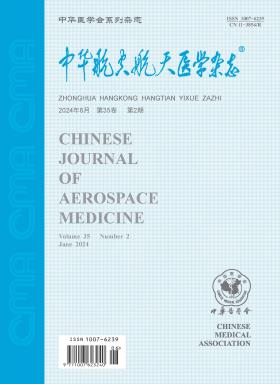戴头盔时头部和颈部对-Gx加速度的动态响应
引用次数: 0
摘要
目的通过模拟头部和颈部在-Gx加速度下的运动并测量力学参数,分析头部和颈部在-Gx加速度下的动力学响应,评价头盔的稳定性。方法以HYBRID型假人的头颈为基础设计摆锤。当摆摆向前移动时,颈部下端的身体撞击波发生器。测量了冲击加速度、头部响应、颈部下端力和扭矩以及头盔位移。比较了戴头盔和戴头盔显示器两种状态下假人头颈部动态响应和头盔位移的差异。结果假人头颈部下端的力和扭矩持续时间明显长于冲击加速度。与头盔相同,冲击加速度-Gx峰值幅值为(6.82±0.27)G,脉宽为(42.63±1.04)ms,头部响应加速度-Gx峰值幅值为(5.66±0.16)G,脉宽为(173.91±2.31)ms,颈部下端力和扭矩分别为(390.37±10.98)N,(183.51±6.26)ms,(79.64±2.70)N·m,(164.17±1.53)ms。头盔相对头部的角位移为(13.16°±4.61°),直线位移为(21.51±10.58)mm。戴头盔状态与戴头盔显示器状态的头部响应加速度、颈部下端力和扭矩脉宽差异均有统计学意义(t=12.947、3.105、17.871,P<0.05)。实验表明,带显示器的头盔位移更大。戴头盔和戴头盔显示两种状态下的冲击峰值加速度和脉冲宽度与头部响应的差异均有统计学意义(t=20.48 ~ 485.26, P<0.01)。结论摆锤试验方法能基本反映头颈部对-Gx加速度的动力学响应和运动特征。研究结果对评价头颈部的安全性和头盔的稳定性具有重要意义。关键词:加速度;头部保护装置;颈部;动态响应本文章由计算机程序翻译,如有差异,请以英文原文为准。
Dynamics response of head and neck to -Gx acceleration when wearing helmet
Objective
To analyze the dynamics response of head and neck to -Gx acceleration and to evaluate the stability of helmet by simulating the movement of head and neck under -Gx acceleration and measuring the mechanics parameters.
Methods
A swing pendulum was designed based on the head and neck of HYBRID III dummy. The body at the lower end of neck impacted the wave generator when the pendulum swing moved forward. The acceleration of impact, head response, force and torque at lower end of neck and helmet displacement were measured. The differences on dummy's head and neck dynamic response and the displacement of helmet were compared between the states of wearing helmet and wearing helmet mounted display.
Results
The duration of force and torque at the lower end of dummy′s head and neck was significantly longer than that of impact acceleration. As with the helmet, -Gx peak amplitude of the impact acceleration was (6.82±0.27) G and the pulse width was (42.63±1.04) ms, the peak amplitude and pulse width of head response acceleration was (5.66±0.16) G and (173.91±2.31) ms, the force and torque at lower end of neck was (390.37±10.98) N and (183.51±6.26) ms, (79.64±2.70) N·m and (164.17±1.53) ms respectively. The angular and linear displacement of the helmet relative to head was (13.16°±4.61°) and (21.51±10.58) mm respectively. There were statistically significant differences on pulse width of head response acceleration, force and torque at lower end of neck between the states of wearing helmet and wearing helmet mounted display (t=12.947, 3.105, 17.871, P<0.05). The experiment showed that helmet with display caused bigger displacement. There were statistically significant differences on the peak acceleration and pulse width between the impact and the head response both under the states of wearing helmet and wearing helmet mounted display (t=20.48-485.26, P<0.01).
Conclusions
The swing pendulum test method could basically reflect the dynamics response and motion features of head and neck to -Gx acceleration. The results have important significance on evaluating the safety of head and neck and stability of helmet.
Key words:
Acceleration; Head protective device; Neck; Dynamics response
求助全文
通过发布文献求助,成功后即可免费获取论文全文。
去求助
来源期刊

中华航空航天医学杂志
航空航天医学
自引率
0.00%
发文量
2962
期刊介绍:
The aim of Chinese Journal of Aerospace Medicine is to combine theory and practice, improve and popularize, actively advocate a hundred flowers bloom and a hundred schools of thought contend, advocate seeking truth from facts, promote the development of the related disciplines of aerospace medicine and human efficiency, and promote the exchange and penetration of aerospace medicine and human efficiency with other biomedical and engineering specialties.
Topics of interest for Chinese Journal of Aerospace Medicine include:
-The content of the journal belongs to the discipline of special medicine and military medicine, with the characteristics of multidisciplinary synthesis and cross-penetration, and mainly reflected in the aerospace industry, aerospace flight safety and efficiency, as well as the synthesis of special medicine, preventive medicine, environmental medicine, psychology, etc.
-Military aeromedicine (Air Force, Navy and Army aeromedicine) and civil aeromedicine, with a balance of aerospace medicine are the strengths of the journal.
-The change in aerospace medicine from a focus on promoting physiological compensatory adaptations to enhancing human performance under extreme environmental conditions is what the journal is helping to promote.
-The expansion of manuscripts in high altitude medicine is also a special emphasis of the journal.
 求助内容:
求助内容: 应助结果提醒方式:
应助结果提醒方式:


